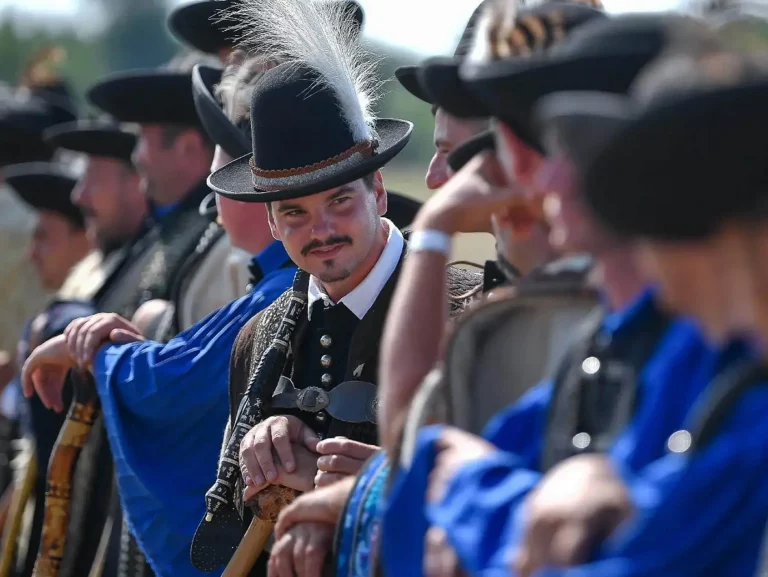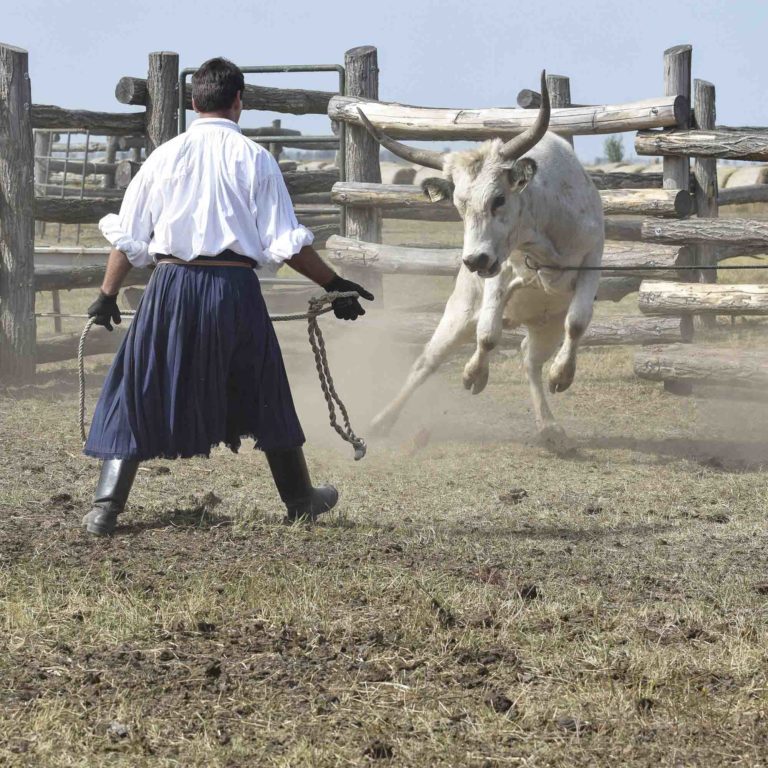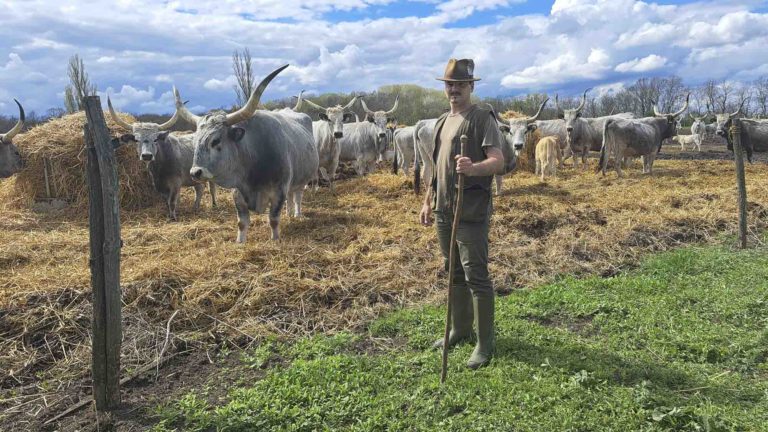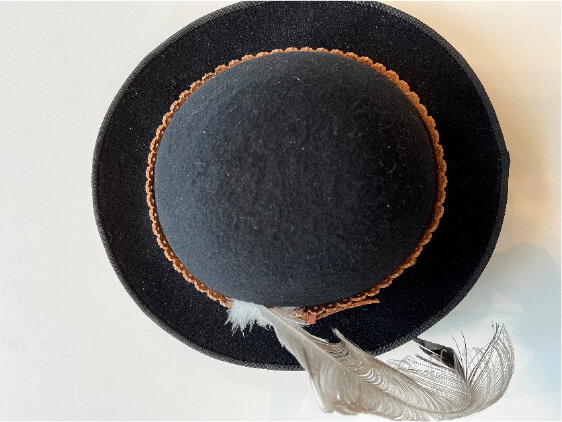May I introduce myself? I am Bálint´s hat!
I am going to tell you my story about this very exceptional herder´s apprentice – hats off for Bálint
I am a traditional Hungarian herder´s hat made of felt. I am so sturdy that a person can easily step on me. I protect my owners from wind, rain and sun. Traditionally, only experienced herders can wear me. But now I will tell you the story about a talented young herder, Bálint Sándor. He is allowed to wear me although he is still an apprentice.
Bálint’s grandparents had a farm, so he was used to being close to animals. In his early twenties, he heard the call of destiny. He went to a farm next to his hometown with horses, cattle and buffaloes. “I said to the farmers: I have a whip and I would like to go out with the animals. They gave me a horse and made me bring in 40 other horses from the pasture – all by myself. I didn´t break my neck – so, that was a start,” he said. He worked with the horses and the cattle for one and a half years, but without any professional help. That was an extreme challenge and he made mistakes – but also had invaluable experiences. Chapeau!
Meeting a chief herder
A couple of years ago, Bálint met the chief herder Mátyás Lehoczki and asked him whether he could become his apprentice. The herder observed his every move for a long time. Then gradually he granted him more responsibility with the cattle. They are friends now, the chief and the apprentice. And now, the chief passes on his traditional knowledge to Bálint. He gives him hints where to go and with whom to collaborate. And after Bálint’s first successful herder´s competition he gave him a great white egret feather for me – the hat. This was a very exceptional honour for both of us. Usually only well-respected herders are bestowed with it. But Mátyás told Bálint: “You deserve it.”
Scientific approach
Bálint, now 28 years old, works for the Centre for Ecological Research in Hungary. It is located in Vácrátót, close to Budapest. As a wildlife management and nature protection engineer, he has the perfect professional background. Bálint collaborates closely with Dr. Zsolt Molnár. The ethnoecologist is scientific advisor at the Centre for Ecological Research. He is also head of the Traditional Ecological Knowledge Research group, and a very outspoken supporter for traditional herders in Hungary. The Hungarian version of his YouTube film „An afternoon on the pasture with the Shepherd László Sáfián“ has scored the incredible number of 653,000 viewers. Even more astounding: More than 100,000 watched the whole 3-hour film! Zsolt has a very clear idea about pastoral culture. “Herders and their knowledge can efficiently help to maintain the unique biodiversity of pastures in Central Europe.” From my hat´s perspective, I couldn´t agree more!
BIOTraCes – wearing many hats
Since December 2022, he and Bálint are part of the EU-funded research project BIOTraCes.
The project will develop knowledge, tools and new approaches towards a society in harmony with nature. This will help to boost biodiversity across Europe. BIOTraCes aims at tackling public policies, and local and corporate strategies to be more inclusive and fair. Thus, BIOTraCes is in line with the European Green Deal and the Sustainable Development Goals of the United Nations. Within the four-year project, the researchers will perform nine case studies. One will be in Hungary with a group of male and female herders. Zsolt and Bálint want to increase the respect for traditional herding in policies and the wider public. Zsolt has been studying traditional herding in depth and is one of the experts in the field worldwide. “Traditional herding is special because it is based on intensive observation,” he said. “A traditional herder spends all day with his animals, thinks about them even in the night, and sees each of them – of which there are hundreds – as individuals with diverse personalities. All their activities are based on this detailed observation work.”
A lonesome cowboy?
And Bálint has to observe the cattle very closely, always being alert. At his chief herder’s herd he can handle 200 at a time. Like humans, they have very different characters. They can be calm, but also very aggressive, such as cows with young calves. Bálint has learned how to handle difficult situations peacefully, but very strongly. And most importantly, alone. This experience changed his whole approach towards life. “I know now that I can make difficult decisions very fast,” he said. “I can handle everything. This has made me a very calm and relaxed person – and very self-confident. It also gives me the ultimate freedom of decision-making. All by myself, based on observation and care for the animals.” Definitely not an old hat!
Being picky
Usually, a herder takes the cattle in the early morning to grasslands with their least favourite plants to graze. The reason is that cows are very picky. And if the herders wouldn´t manage their grazing habits, the cows would be satiated with their preferred plants. This would lead to the degradation of grasslands. Maintaining the delicate balance between grazing and keeping pastures healthy is one of the main tasks of herders. The cows´ favourite plants are reserved for the second round of grazing in the afternoon. That makes the cattle full, content and calm – like humans after their favourite meal.
Doing the maths of managing dung
Let me tell you one thing very confidentially: The inevitable result of grazing is dung. And lots of it, with the excretions of 200 cattle. But it should only cover a certain percentage of a grazing area, in some areas there must be enough space left for cattle to graze. The vegetation of the grassland must be kept well and the dung enhance plant growth. Besides, there are many different seeds in the dung from tasty grass for the cattle, or protected species of plants, which can be spread this way. So, Bálint has to do the maths for managing the dung to maintain the biological diversity of the pastures.
Even more challenges
And there are more challenges – such as the weather. Bálint learned that herders have to graze the cattle every single day of the season – without any exception. The cattle won´t wait. They must be kept well-fed, healthy and happy. But, society and policy makers are even more challenging. “In my area, I couldn´t make a living as an employed herder because you hardly get paid for it,” he says. “Also, people still don’t understand how important herding is for nature. Apart from some folkloristic clothes, the respect for pastoral culture in Hungary is very low.” But Bálint would like to change that. Together with Zsolt Molnár, they want to give herders a strong voice in Europe. And also: respect, recognition and decent salary.
Now you have read my story of the herder´s apprentice Bálint Sándor. And although I protect Bálint so well, herding is a demanding task. All year round, all alone, in all kinds of weather. But it has changed Bálint’s perspective on life. “The animals will teach you to understand nature. And anything you don‘t know about life, animals will teach you. If you don’t believe me, try it for a year. After that, you will understand.“
Hats off for you, Bálint!




